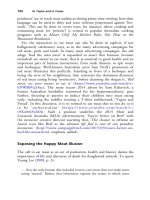The palgrave international handbook of a 241
Bạn đang xem bản rút gọn của tài liệu. Xem và tải ngay bản đầy đủ của tài liệu tại đây (33.57 KB, 1 trang )
236
J. Maher and T. Wyatt
influenced these responses but, crucially, that it is seldom the central focus.
In practical terms, these responses aim to reduce IWT offences and protect
species rather than individual wildlife victims. Consequently, enforcement
agencies are commonly ‘fire-fighting’; responding after significant harms
occur, many of which will be irreversible.
Political Mobilisation and Support
The 1975 CITES convention, a flagship international wildlife agreement,
united governments worldwide in regulating the wildlife trade and protecting
threatened species. Subsequently, however, limited political mobilisation has
impeded their response (impacting negatively on legislation, enforcement,
prosecution, sentencing and societies response). It is only in recent years,
with growing concerns over biodiversity loss and the widespread consequences of the trade, that political mobilisation involving global and international entities and consortiums, national governments and civil society (for
example, Bangkok 16 CITES and London IWT Conference), through
international declarations, resolutions and operations, has renewed political
momentum and enhanced policy responses. The scale and nature of problems associated with the IWT are now widely recognised, however, the
focus remains anthropocentric, regarding the harms—such as the loss of
iconic species—as affecting humans, rather than the individual animals.
Political support for protecting wildlife is thus limited until this focus
expands to include the environmental costs to ecosystems and the animals
themselves (Maher and Sollund 2016).
Legislation
The CITES convention requires the 180 Member State parties to monitor
and regulate the wildlife trade through dedicated domestic legislation based
on the three aforementioned lists—Appendix I, II and III—which respectively ban, regulate and monitor trade. However, member states do not share
common domestic IWT legislation, creating opportunities for fractures and
loopholes which impact upon the effectiveness of CITES. The UK, for
example, under the EU Council Regulations (338/97), provides a more
robust national implementation of CITES through the Control of Trade
in Endangered Species [COTES] (1997). The CITES appendices are









